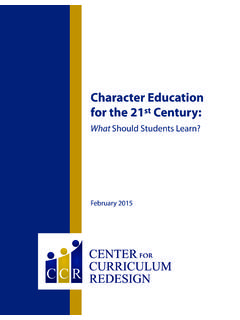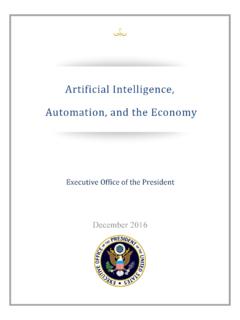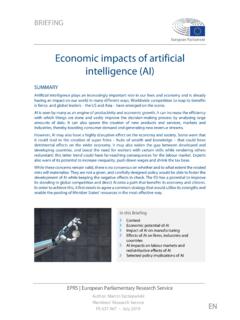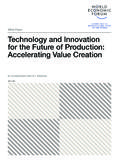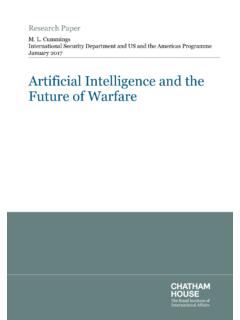Transcription of Artificial Intelligence In Education
1 Artificial Intelligence In Education Promises and Implications for Teaching and Learning Wayne Holmes, Maya Bialik, Charles Fadel Center for Curriculum Redesign All Rights Reserved The Center for Curriculum Redesign, Boston, MA, 02130. Copyright 2019 by Center for Curriculum Redesign All rights reserved. Printed in the United States of America Artificial Intelligence in Education Promises and Implications for Teaching and Learning ISBN-13: 978-1-794-29370-0. ISBN-10: 1-794-29370-0. A pdf version with active links is available at: BOOK. Keywords: Education technology, EdTech, Artificial Intelligence , machine learning, deep learning, AI, AIED, curriculum, standards, competencies, competency, CBL, deeper learning, knowledge, skills, character, metacognition, meta-learning, mindset, 21st century Education , social- emotional skills, 21st century competencies, Education redesign, 21st century curriculum, pedagogy, learning, jobs, employment, employability, eduployment, Education 2030, fourth Industrial Revolution, exponential technology, personalized learning, competency-based learning, individualized learning, adaptive learning.
2 Center for Curriculum Redesign All Rights Reserved Introduction: The Context Artificial Intelligence (AI) is arguably the driving technological force of the first half of this century, and will transform virtually every industry, if not human endeavors at Businesses and governments worldwide are pouring enormous sums of money into a very wide array of implementations, and dozens of start-ups are being funded to the tune of billions of dollars. Funding of AI startup companies worldwide, from 2013 to 2017. (in millions of dollars). Source: Statista2. It would be naive to think that AI will not have an impact on Education au contraire, the possibilities there are profound yet, for the time being, overhyped as well. This book attempts to provide the right balance between reality and hype (per the Gartner diagram that follows), between true potential and wild extrapolations.
3 Every new technology undergoes a period of intense growth of reputation and expectations, followed by a precipitous fall when it inevitably fails to live up to the expectations, after which there is a slower growth as the technology is developed and integrated into our lives. As visualized in the Gartner diagram, each technology can be said to reside somewhere on the curve 1 Possibly matched only by biotechnology. 2 year 2 Artificial Intelligence in Education at any given time (for example Deep Learning, which is part of AI, is currently peaking). Source: Gartner It is of course a risky proposition then, in a field moving so fast, to attempt to predict the future. As such, this work will likely be updated periodically to keep up with the developments (just as you would expect from software/apps). This book is organized around a somewhat glib quote: There are only two problems in Education : What we teach, and how we teach it.
4 4. Hence this book is divided into two parts, one focused on the What, and one on the How of AI in Education . 3 4 Dr Roger Schank, Artificial Intelligence in Education 3. The What We're headed for a world where you're either going to be able to write algorithms or be replaced by algorithms. Bridgewater hedge-fund billionaire Ray Dalio The first part of this book explores the question: What should students learn in an age of AI? And all the corollary, provocatively phrased questions: If you can search, or have an intelligent agent find, anything, why learn anything? What is truly worth learning? . It is widely expected that AI will have an enormous impact on what we teach, as it will impact many occupations. Take for instance the Organization for Economic and Co-operative Development (OECD). Programme for the International Assessment of Adult Competencies (PIAAC)5 survey, which measures adults' proficiency in key information- processing skills literacy, numeracy and problem solving in technology- rich environments and gathers information and data on how adults use their skills at home and at work.
5 Already, AI is matching more than 50%. of adult human-proficiency levels, and closing in on another 36%. Proficiency Level OECD Adults Artificial Intelligence 2 and below 53% Yes 3 36% Close 4 5 11% No Source: Elliott Stuart, Computers and the Future of Skill Demand. 6. Such progress is bound to continue at an accelerating , pace. IBM's Open Leaderboard effort attempts to understand the progress being made by tracking many variables. According to IBM's Leaderboard, AI. should be getting into the realm of deeper self-learning by the early 2020s 5 6 en#page1. Center for Curriculum Redesign All Rights Reserved 4 Artificial Intelligence in Education and become capable of assisting, collaborating, coaching and mediating by the early 2030s. Perceive World Develop Cognition Build Relationships Fill Roles Coach & Mentor Understanding Conversations Collaborator Recognition Interactions Assistant &.
6 Reasoning Memory Pattern Fluent Social Video Learning from Labeled Training Data and Searching (Optimization). Learn by Watching and Reading ( Education ). Learn by Doing and being Responsible (Exploration). 2015 2018 2021 2024 2027 2030 2033 2036. Source: Jim Spohrer, IBM7. Given all the above, the What section makes a case for the necessity to focus on a broad, deep, and versatile Education as a hedge against uncertain futures, which in turn means a reinvigorated focus on the deeper learning goals of a modern Education : Versatility, for robustness to face life and work. Relevance, for applicability, and student motivation. Transfer,8 for broad future actionability. All of which are to be developed via: Selective emphasis on important areas of traditional knowledge. The addition of modern knowledge. A focus on essential content and core concepts.
7 Interdisciplinarity, using real-world applications. Embedded skills, character, and meta learning into the knowledge domains. 7 IBM, 2017, Cognitive Opentech Group. 8 This refers to the transfer of knowledge from a domain it was learned in to another domain. Artificial Intelligence in Education 5. The How The second part of this book addresses the question: How can AI. enhance and transform Education ? First, it is important to make the distinction between Education technology (EdTech) at large and Artificial Intelligence in Education (AIED) specifically. A quick summary of the affordances of EdTech is appropriate at this stage, as the taxonomy and ontology of the field is quite murky. Using the SAMR9 model that follows, the How section showcases how AIED will span all layers, with its maximum impact growing as it moves up the stack.
8 Substitution, augmentation, modification, and redefinition model (SAMR). Note that the examples shown in the preceding figure represent today's apps, not tomorrow's, and only serve to help explain the model. Often these apps are collapsed under one term, technology, and then there is much confusion about the potential of technology. This model helps us to delineate the different types of impact that technology can have, from mere substitution with no functional changes, all the way through the creation of new, previously inconceivable tasks as a result of technology. 9 Dr. Ruben Puentedura, Center for Curriculum Redesign All Rights Reserved 6 Artificial Intelligence in Education The Role of Assessments What gets measured gets managed. Lord Kelvin Assessments have been the hidden villain behind a lot of Education debates, and a powerful one at enshrining institutional inertia.
9 Repurposing the famous Aristotelian syllogism:10. Lack of, or poor, Education is at the root of many human problems. Assessments define the Education we get. Therefore, assessments are the root of many human problems. Although not a focus of this book, it is clear that assessments have an oversized role to play in the change process, and as part of the AI-driven systems of (mostly formative) assessments. Andreas Schleicher, director of the OECD's Directorate of Education and Skills, publicly stated What is easy to measure is also easy to automate, thereby throwing the gauntlet to the assessment world to readjust its focus and thus drive change. Lastly Readers will have different priorities and interest in this topic. Policymakers and curriculum designers may initially favor the What section, while teachers and IT specialists may at first favor the How section.
10 The What and How sections are therefore written to be independent of each other; the appendices also reflect an emphasis on digestibility, particularly for the technical details. Further, we are all pressed for time, so our writing philosophy is, to use Antoine de Saint-Exup ry's words, Perfection is attained not when there is no longer anything to add, but when there is no longer anything to take away. This book is therefore not meant to be an in-depth 10 All men are mortal. Socrates is a man. Socrates is mortal. Artificial Intelligence in Education 7. academic piece, but rather it is meant to be concise and to the point, and adhere to Yuval Harari's philosophy: In a world deluged with irrelevant information, clarity is power. 11. We wish you all very pleasant reading, and invite your feedback at: 11 Harari, Y. (2018). 21 Lessons for the 21st Century.

